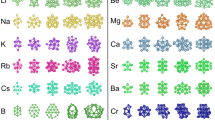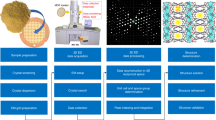Abstract
Advances in materials science and molecular biology followed rapidly from the ability to characterize atomic structure using single crystals1,2,3,4. Structure determination is more difficult if single crystals are not available5. Many complex inorganic materials that are of interest in nanotechnology have no periodic long-range order and so their structures cannot be solved using crystallographic methods6. Here we demonstrate that ab initio structure solution of these nanostructured materials is feasible using diffraction data in combination with distance geometry methods. Precise, sub-ångström resolution distance data are experimentally available from the atomic pair distribution function (PDF)6,7. Current PDF analysis consists of structure refinement from reasonable initial structure guesses6,7 and it is not clear, a priori, that sufficient information exists in the PDF to obtain a unique structural solution. Here we present and validate two algorithms for structure reconstruction from precise unassigned interatomic distances for a range of clusters. We then apply the algorithms to find a unique, ab initio, structural solution for C60 from PDF data alone. This opens the door to sub-ångström resolution structure solution of nanomaterials, even when crystallographic methods fail.
This is a preview of subscription content, access via your institution
Access options
Subscribe to this journal
Receive 51 print issues and online access
$199.00 per year
only $3.90 per issue
Buy this article
- Purchase on Springer Link
- Instant access to full article PDF
Prices may be subject to local taxes which are calculated during checkout



Similar content being viewed by others
References
Friedrich, W., Knipping, P. & Laue, M. Interference appearances in x-rays. Ann. Phys.(Berlin) 41, 971–988 (1913); reprinted from Sitzb. K. Bayer. Akad. Wiss. 303–322 (1912).
Bragg, W. H. & Bragg, W. L. The reflection of x-rays by crystals. Proc. R. Soc. Lond. A 88, 428–438 (1913)
Perutz, M. F. et al. Structure of haemoglobin: a three-dimensional Fourier synthesis at 5.5?Å resolution, obtained by x-ray analysis. Nature 185, 416–422 (1960)
Kendrew, J. B. et al. Structure of myoglobin: a three-dimensional Fourier synthesis at 2?Å resolution. Nature 185, 422–427 (1960)
David, W., Shankland, K., McCusker, L. & Baerlocher, C. (eds) Structure Determination from Powder Diffraction Data (Oxford Univ. Press, Oxford, UK, 2002)
Billinge, S. J. L. & Kanatzidis, M. G. Beyond crystallography: the study of disorder, nanocrystallinity and crystallographically challenged materials. Chem. Commun., 749–760 (2004)
Egami, T. & Billinge, S. J. L. Underneath the Bragg Peaks: Structural Analysis of Complex Materials (Pergamon, Oxford, UK, 2003)
Zuo, J. M., Vartanyants, I., Gao, M., Zhang, R. & Nagahara, L. A. Atomic resolution imaging of a carbon nanotube from diffraction intensities. Science 300, 1419–1421 (2003)
Millis, A. J. Lattice effects in magnetoresistive manganese perovskites. Nature 392, 147–150 (1998)
Zhang, H. Z., Gilbert, B., Huang, F. & Banfield, J. F. Water-driven structure transformation in nanoparticles at room temperature. Nature 424, 1025–1029 (2003)
Clore, G. M. & Gronenborn, A. M. Determining the structures of large proteins and protein complexes by NMR. Trends Biotechnol. 16, 22–34 (1998)
Nilges, M. & O'Donoghue, S. I. Ambiguous NOEs and automated NOE assignment. Prog. Nucl. Magn. Reson. Spectrosc. 32, 107–139 (1998)
Wright, A. Diffraction studies of glass structure: the first 70 years. Glass Phys. Chem. 24, 148–179 (1998)
Gilbert, B., Huang, F., Zhang, H., Waychunas, G. & Banfield, J. Nanoparticles: Strained and stiff. Science 305, 651–654 (2004)
Page, K. et al. Direct observation of the structure of gold nanoparticles by total scattering powder neutron diffraction. Chem. Phys. Lett. 393, 385–388 (2004)
Chupas, P. J. et al. Rapid acquisition pair distribution function analysis (RA-PDF). J. Appl. Crystallogr. 36, 1342–1347 (2003)
Petkov, V. et al. Structure of nanocrystalline materials using atomic pair distribution function analysis: study of LiMoS2 . Phys. Rev. B 65, 092105 (2002)
McGreevy, R. L. & Pusztai, L. Reverse Monte Carlo simulation: a new technique for the determination of disordered structures. Mol. Simul. 1, 359–367 (1988)
Soper, A. K. Empirical potential Monte Carlo simulation of fluid structure. Chem. Phys. 202, 295–306 (1996)
Biswas, P., Tafen, D. & Drabold, D. A. Experimentally constrained molecular relaxation: The case of glassy GeSe2 . Phys. Rev. B 71, 054204 (2005)
Crippen, G. M. & Havel, T. F. Distance Geometry and Molecular Conformation (Wiley & Sons, New York, 1988)
Hendrickson, B. The molecule problem—exploiting structure in global optimization. SIAM J. Optimiz. 5, 835–857 (1995)
Deaven, D., Tit, N., Morris, J. & Ho, K. Structural optimization of Lennard-Jones clusters by a genetic algorithm. Chem. Phys. Lett. 256, 195–200 (1996)
Wales, D. J. & Scheraga, H. A. Review: Chemistry - global optimization of clusters, crystals, and biomolecules. Science 285, 1368–1372 (1999)
Cai, W. S. & Shao, X. G. A fast annealing evolutionary algorithm for global optimization. J. Comput. Chem. 23, 427–435 (2002)
Kirkpatrick, S., Gelatt, C. D. & Vecchi, M. P. Optimization by simulated annealing. Science 220, 671–680 (1983)
Hartke, B. Global cluster geometry optimization by a phenotype algorithm with niches: Location of elusive minima, and low-order scaling with cluster size. J. Comput. Chem. 20, 1752–1759 (1999)
Thorpe, M. F., Levashov, V. A., Lei, M. & Billinge, S. J. L. in From Semiconductors to Proteins: Beyond the Average Structure (eds Billinge, S. J. L. & Thorpe, M. F.) 105–128 (Kluwer/Plenum, New York, 2002)
Deaven, D. M. & Ho, K. M. Molecular-geometry optimization with a genetic algorithm. Phys. Rev. Lett. 75, 288–291 (1995)
Acknowledgements
We thank A. P. Ramirez and R. C. Haddon for supplying the C60 sample. P.J. appreciates discussions with J. Bloch and E. S. Božin. P.M.D. acknowledges support from the Department of Energy (DOE) and S.J.L.B. from the NSF NIRT programme. Neutron data were collected at the GLAD instrument IPNS, which is funded by DOE.
Author information
Authors and Affiliations
Corresponding author
Ethics declarations
Competing interests
Reprints and permissions information is available at npg.nature.com/reprintsandpermissions. The authors declare no competing financial interests.
Supplementary information
Supplementary Movie 1
Reconstruction of 88-atom Lennard-Jones cluster from unlabelled pair distances. The movie shows reconstruction of LJ-88 cluster from unlabelled pair distances using the Liga algorithm. The procedure starts by building up partial clusters using only allowed distances. Growth from defective subclusters leads to appearance of high-error (red) atoms. Badly placed atoms are removed allowing convergence to the correct structure. (MPG 2866 kb)
Rights and permissions
About this article
Cite this article
Juhás, P., Cherba, D., Duxbury, P. et al. Ab initio determination of solid-state nanostructure. Nature 440, 655–658 (2006). https://doi.org/10.1038/nature04556
Received:
Accepted:
Issue Date:
DOI: https://doi.org/10.1038/nature04556
This article is cited by
-
Trilateration Using Unlabeled Path or Loop Lengths
Discrete & Computational Geometry (2024)
-
Long-range ordered porous carbons produced from C60
Nature (2023)
-
Extracting structural motifs from pair distribution function data of nanostructures using explainable machine learning
npj Computational Materials (2022)
-
Unassigned distance geometry and molecular conformation problems
Journal of Global Optimization (2022)
-
Powder diffraction
Nature Reviews Methods Primers (2021)
Comments
By submitting a comment you agree to abide by our Terms and Community Guidelines. If you find something abusive or that does not comply with our terms or guidelines please flag it as inappropriate.



